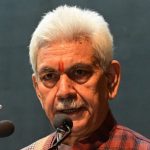This Sunday, as I dozed off at home, I felt as if I were a child again, in my lower teens, listening to the soothing voice of my late mother as she told me local folk tales in the evening to help me sleep. It was as if she was telling me the story of “Aka Nandun“once more.
Kashmiri folklore is a vibrant part the “literature of the people” of India, capturing the hopes, wisdom, and experiences of its people for ages. This oral tradition, passed down through generations, acts as both a mirror reflecting the collective consciousness and a bridge connecting the past with the present. The roots of this folklore are ancient, with the earliest collection of Indian folktales, the “Panchatantra”, dating back to the first century AD.
The main language of the Kashmir region, Kashmiri, is spoken by nearly three million people. It has deep roots, derived from Sanskrit and belonging to the Indo-Aryan language family. The richness of the Kashmiri language is evident in its ability to convey complex emotions, subtle nuances, and vivid imagery, making it perfect for storytelling. Kashmiri folk tales are cultural artifacts that encapsulate the values, beliefs, and traditions of the Kashmiri people.
Kashmir has a long and cherished tradition of storytelling. Before modern entertainment, stories were a primary way to hold the attention of children and impart moral lessons. It was common for younger family members to gather around their grandparents to hear their favourite tales. These stories were often passed down from generation to generation, with each storyteller adding their own embellishments and interpretations.
Folktales in Kashmir are as old as the hills that surround the valley. These stories, steeped in the rich cultural heritage, have been preserved and cherished by the people for centuries. Some of the most famous Kashmiri folktales include “Zohra Khatun and Haya Bund,” “Gulala Shah,” “Bombur and Loare,” and “Himal Nagrage.” These stories, deeply embedded in the Kashmiri psyche, are not only entertaining but also serve as a repository of the collective wisdom of the people.
Two of the most treasured collections of Kashmiri fairy tales are “Wazir Mal” and “Lal Mal”. These tales have been rendered into poetry in both Kashmiri and Persian, demonstrating the rich literary tradition of the valley. These collections testify the creativity and imagination of the Kashmiri people, and they continue to inspire new generations.
Kashmiri folklore is not limited to tales; it extends into the realm of folk music, which has a wide range of subject matter, structure, and style. Kashmiri folk music can be categorised into several types, including opera and dance songs, pastoral lore, romantic ballads, play songs, semi-mystic songs, and more. There are also songs performed at specific times of the year or to accompany particular activities, such as lullabies, wedding songs, and dirges.
One unique aspect of Kashmiri storytelling is the use of a particular style of singing known as “Dastaans”. The most well-known of these is Ismal Mir’s Dastaans, often seen on Kashmiri television networks and heard on the radio. These sung narratives are a powerful way of preserving and transmitting the stories of the past.
The story of Aka Nandun
Among the many folktales of Kashmir, the story of Aka Nandun stands out as a tale of deep emotional resonance and profound moral lessons. This story, which has been told and retold over generations, captures the essence of sacrifice, loyalty, and the transformative power of love.
The tale begins with a Hindu couple in Kashmir who have been married for many years but remain childless. Their deep yearning for a child is a source of sorrow and despair. One day, a wandering Yogi visits their home and, sensing their grief, offers them a solution. He tells the couple that he can bless them with a son, but in return, they must promise to give the child back to him when he turns twelve years old. The couple, desperate for a child, agrees to the condition set by the Yogi, even though the terms of the agreement weigh heavily on their hearts.
In due course, the couple is blessed with a beautiful son, whom they name Aka Nandun. The child becomes the light of their lives, bringing them immense joy and fulfillment. The years pass quickly, and the couple cherishes every moment with their son, always mindful of the promise they made to the Yogi. As Aka Nandun grows, he becomes a handsome and virtuous young boy, beloved by all who know him.
As Aka Nandun approaches his twelfth birthday, the couple’s anxiety deepens. The thought of losing their beloved son is unbearable, yet they are bound by their promise. On the day of his twelfth birthday, the Yogi returns to claim the boy. The couple, though heartbroken, prepares to fulfill their vow. They lead Aka Nandun to the Yogi, ready to make the ultimate sacrifice.
However, the story takes an unexpected turn. The Yogi, moved by their wavering loyalty and the deep love they have for their son, decides to spare Aka Nandun’s life. He reveals that his demand was a test of their devotion, and because they have proven their sincerity, he releases them from their promise. The family is overjoyed, and Aka Nandun is returned to them, safe and sound. The tale ends on a note of profound relief and happiness, emphasizing the power of faith, love, and integrity.
The enduring legacy of Kashmiri folktales is evident in the continued interest in these stories, both within the valley and beyond. These tales, with their rich narratives and timeless themes, offer a glimpse into the soul of Kashmir and its people. Whether through the tales themselves, the music that accompanies them or the unique style of singing used to narrate them, these stories continue to captivate and inspire.
Kashmiri folklore is a treasure trove of cultural heritage, offering insights into the values, beliefs, and traditions of the Kashmiri people. These tales speak a lot about the power of storytelling to connect us with our past, enrich our present, and guide our future.
(Author is a columnist and can be reached at: [email protected])








